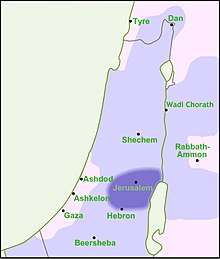Tishbe
Tishbe, sometimes transliterated as Thisbe,[1] is a town mentioned in the Hebrew Bible's First Book of Kings, 1 Kings 17:1, as the residence and possibly even birthplace of the Prophet Elijah, known as the Tishbite (see that page for discussion of the term). It is placed by the biblical text in the historical region of Gilead,[2] now in the western part of modern-day Jordan. However, the toponym may denominate another location, as discussed below.
Possible locations
Tishbe in Gilead

1 Kings 17:1 indicates that Elijah was from Tishbe in Gilead, which is a historical region located east of the Jordan River in present Jordan. The Jewish ancient historian Josephus supposed that Tishbe was in Gilead.[3] The eastern half of the Israelite Tribe of Manasseh and, possibly also, the Tribe of Gad, have been in possession of Gilead; therefore Tishbe was probably in the territory of the eastern half of Manasseh, or possibly in that of Gad. According to Pfieffer and Vos, it is located in the territory of Manasseh, in proximity to the wadi known from the Bible as Cherith, in present-day Jordan.[4]
Tishbe has for a long time been identified as the historical town of Listib in Gilead, due to its location and the similarity between the ancient Hebrew name and the Arabic name, "el-Istib", but the 1915 International Standard Bible Encyclopedia refutes the identification because el-Istib has only been established during the Byzantine period.[2] Todd Bolen writes on BiblePlaces.com that the current candidates for Tishbe may be one of three locations in the vicinity of Tell Mar Elias, or simply "Mar Elias", where a Byzantine church was erected in Elijah's memory: other than Listib, Umm el-Hedamus and Abu Hummus.[5] The ruins of Listib are located 13 kilometres north of the Jabbok River in Gilead, known in Arabic as the Zarqa River, just west of biblical Mahanaim,[2] a short distance beyond the northwest limits of Ajloun in the Ajloun Governorate in northern Jordan.
Tishbe in Naphtali
Alternatively, Tishbe may be identical to the as of yet undiscovered "Thisbe" referenced in Tobit (Tobit 1:2), which was located west of the Jordan River in the territory of the Tribe of Naphtali, because Listib in historical Gilead east of the Jordan River is known to have been uninhabited during the time of the Northern Kingdom of Israel.[6]
References
- "An Exposition, with Practical Observations, of the First Book of Kings", Christian Classics Ethereal Library
- International Standard Bible Encyclopedia (1915), Tishbite, via BiblicalTraining.org, accessed 2020-01-13
- Ant., 8: 13, 2.
- Charles F. Pfeiffer and Howard Frederic Vos, The Wycliffe Historical Geography of Bible Lands, Map 6 (Chicago, Illinois: Moody Press, 1967).
- Tedd Bolen, Upper Gilead: Tishbe, Home of Elijah, on BiblePlaces.com, accessed 2020-01-13
- Harrison, R. K., "Tishbite", in G. W. Bromiley, gen. ed., International Standard Bible Encyclopedia, Rev., Vol. 4, p. 861 (Grand Rapids, Michigan: Eerdmans, 1988).